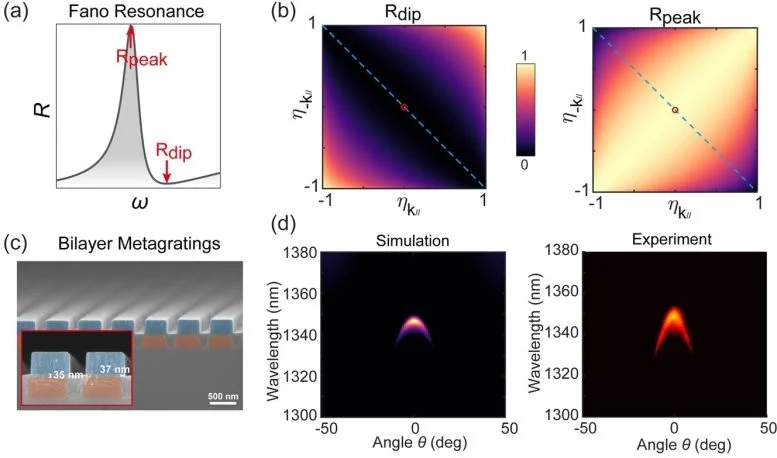 Schematic of tailoring the resonant reflection via radiation directionality in misaligned metagratings. The novel bilayer metagratings selects only a single angle and a single wavelength under incidence with broadband spectrum and wide angles. This is achieved through a directional eraser, that precisely suppresses lights spectral signature along a dispersion curve. Credit: Ze-Peng Zhuang, Xin Zhou et al.
Schematic of tailoring the resonant reflection via radiation directionality in misaligned metagratings. The novel bilayer metagratings selects only a single angle and a single wavelength under incidence with broadband spectrum and wide angles. This is achieved through a directional eraser, that precisely suppresses lights spectral signature along a dispersion curve. Credit: Ze-Peng Zhuang, Xin Zhou et al.
Scientists have broken a fundamental limit in optics by decoupling angle and wavelength using innovative bilayer metagratings.
Wavelength and the direction in which light travels (angle) are two essential characteristics that define how light behaves. Gaining precise control over both of these properties is critical to the function of many advanced optical technologies.
However, in systems with repeating structures (periodic systems), a natural dispersion effect creates a built-in link between wavelength and angle. This connection, known as angle-wavelength locking, means that adjusting the angle of incoming light typically causes a shift in the devices filtering wavelength.
This intertwined relationship has long been viewed as unavoidable and presents a major challenge for applications that require separate tuning of angle and wavelength. It leads to significant technical hurdles, such as rainbow-like color artifacts in augmented reality (AR) displays, blurring in wide-field imaging caused by color spreading across angles, reduced accuracy in spectral data from photodetectors due to angular interference, and design constraints for efficient, direction-specific light sources.
A Breakthrough in Radiation Directionality
In a new paper published in eLight, a team of scientists, jointly led by Professor Jian-Wen Dong from Sun Yat-sen University, and Lei Zhou from Fudan University, have discovered that the radiation directionality of optical modes is key to overcoming this fundamental challenge. Through theoretical analysis, they established a complete phase diagram for engineering resonant spectra via radiation directionality, revealing that spatial inversion symmetry and highly directional radiation of optical modes are the essential physical conditions for breaking angle-wavelength locking.
 Theoretical design and experimental realization of the misaligned bilayer metagratings. a. a typical Fano resonance resulting from guided-resonance modes in bilayer metagratings. b. The reflection dip and peak of Fano resonance as functions of radiation directionality of guided-resonance modes with matched in-plane momentum k// and -k//. The red dots correspond to the case of mirror symmetry and dashed lines represent the case of P symmetry. c. Scanning electron microscope images of the fabricated bilayer metagratings sample. d. Angle-resolved reflection spectrum in simulation and experiment. Credit: Ze-Peng Zhuang, Xin Zhou et al.
Theoretical design and experimental realization of the misaligned bilayer metagratings. a. a typical Fano resonance resulting from guided-resonance modes in bilayer metagratings. b. The reflection dip and peak of Fano resonance as functions of radiation directionality of guided-resonance modes with matched in-plane momentum k// and -k//. The red dots correspond to the case of mirror symmetry and dashed lines represent the case of P symmetry. c. Scanning electron microscope images of the fabricated bilayer metagratings sample. d. Angle-resolved reflection spectrum in simulation and experiment. Credit: Ze-Peng Zhuang, Xin Zhou et al.
Based on this, they introduced a degree of lateral displacement in bilayer metagratings. This design preserves spatial inversion symmetry while breaking vertical mirror symmetry, enabling precise angular control of radiation directionality. Theoretically, they predicted that resonant reflection occurs only at normal incidence and near the central wavelength. They also proposed general designs for achieving spatio-spectral selectivity at arbitrary angles and wavelengths.
Radiation directionality acts like a magical eraser, allowing us to precisely suppress lights spectral signature along a dispersion curve. This capability allows for independent selectivity of angle and wavelength, overcoming the limitation imposed by intrinsic dispersion, they summarized.
Overcoming Fabrication Challenges
Experimental fabrication of the bilayer metagratings is another challenge, since achieving both the flatness of ultra-thin spacer layers and the precise lateral misalignment between layers requires sophisticated nanofabrication techniques, they added.
To address this, they have developed a novel fabrication approach involving multiple etching steps, indirect thickness measurements, and iterative deposition processes. This was combined with a high-precision bilayer alignment technique to successfully fabricate high-quality, near-infrared working bilayer metagratings. This method offers excellent spacer flatness and thickness tunability, ~10 nm alignment accuracy, and compatibility with various spacer materials, establishing a flexible experimental platform for studying bilayer photonic systems.
Using this platform, they experimentally demonstrated high reflectance happening only at a single angle and a single wavelength. To confirm that the novel reflectance roots in the radiation directionality, they also performed angle-resolved optical microscopy measurements to characterize the radiation directionality of the sample. By combining temporal coupled-mode theory with cross-polarization measurement techniques, they quantitatively measured the unidirectional radiation of the resonant modes.
Furthermore, the research team has pioneered the development of millimeter-scale, high-precision bilayer metagratings and successfully achieved high-contrast imaging with concurrent spatial- and spectral-frequency selectivity at 0� and 1342 nm. This opens new opportunities for compact optical imaging and optical computing technologies.
This research not only offers an innovative solution to address the fundamental challenge of independently controlling angle and wavelength, but also provides new insights for technological applications such as AR/VR displays, spectral imaging, coherent thermal radiation, and advanced semiconductor manufacturing, the scientists forecast.
Reference: Overcoming intrinsic dispersion locking for achieving spatio-spectral selectivity with misaligned bilayer metagratings by Ze-Peng Zhuang, Xin Zhou, Hao-Long Zeng, Meng-Yu Li, Ze-Ming Chen, Xin-Tao He, Xiao-Dong Chen, Lei Zhou and Jian-Wen Dong, 8 July 2025, eLight.
DOI: 10.1186/s43593-025-00092-y
Never miss a breakthrough: Join the SciTechDaily newsletter.



